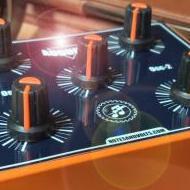Search the Community
Showing results for tags 'USB'.
-
Hi, This does not belong directly to the MIOS, but I haven't found a better sub-forum for my question... I'm trying to learn a lot of the low level stuff associated with MIDI right now. Mostly about USB connection. The svn repo is pretty good for it. I learned a lot of it already... I'm thinking about implementing myself(for learning purposes) a MIDI-USB connection with my STM32f4 dev board. I'm planning to use an ULPI PHY for HiSpeed Connction to achieve lowest latencies(8 times lower latency than FS). I think the Interrupt transfer method should be the best fit for it, since it has guaranteed latency. But now I saw in the svn repo that the MIDI-USB endpoint descriptor uses only bulk as transfer method. Is this just for the compability issue or is it a wrong idea to use the interrupt transfer method, to achieve lowest latencies? Ah just for record, I'm a pretty fussy drummer regarding latencies, since I hear/feel a small difference between 5ms and 10ms(measured and compared by ear...). Best Regards Philipp
-
Last week I have dug up one of my older projects: for a long time I wanted to create large capacitive touch pad that only uses PCB layout as touch-sensitive components. I chose a PIC24FJ128 because it comes with 50 ADC channels that have hardware-support capacitive measurements so I could create a 2D matrix similar to a Freescale reference design. Note how on one side of the pcb there is no single component so it should fit nicely directly under the hood for many projects. But I assume it's a bit large for some applications. This single-side-placement design lead to only SMD parts being used. Sorry it's not really DIY. In theory the thing should be rather cheap. I'm guessing 10-25€ with the majority being for placement & soldering of the TQFP100. Eventually it will communicate via SPI and should thus be midibox-compatible but it should also be usable as a standalone USB device and either be a mouse or a midi controller that sends CC messages directly to your DAW. We'll see about what can be done. I'm thinking in some cases even multi-touch may be possible but I'll have to experiment with the algorithms here. My plan was to start designing the finger tracking algorithms on the PC. For this I was hoping to intially have the ADC data transmitted over USB in real time to my PC application where I could prototype algorithms. So this would be yet a third USB device type I need in the beginning but which will not be available after development has finished. About 3 years ago it turned out developing a USB stack for a PIC µC with the tools available back then is a real pain. It lead to me dropping the project. I don't have much more time these days but maybe someone is interested in a collaboration? Or maybe you guys know if the tools are better today? Is there anyone out there who would have an easy time developing µC C code for the USB stacks I mentioned? I'm currently based in Munich, Germany but this is not a must! Furthermore, would anybody be interested in actually having some of these (given I/we manage to get to a stable version that can be released) ?
-
Hello all, I want to connect more than one USB midi device to my SEQ4, without connecting a full-blown computer. So I have some spare Raspberry Pi's laying around. Model B+, so 4 USB ports. I already tinkered some things and I ended with a program called osc2midi (and back). I can send to my SEQ4 and I can also receive from the SEQ4 thus communication is established. Now I run into formatting problems. With help from the creator of osc2midi I found out I have to use the m-datatype in the conversion, but it look like the data is interpreted different. SEQ4 OSC is set to Midi-messages. Then I send from SEQ4 to osc2midi I receive: /midi1 m, MIDI [0x90 0x3c 0x35 0x00] When I sent from osc2midi, it sends: /midi1 ,m MIDI [0x00 0x90 0x3c 0x39] Osc2midi uses a single variable, so I can't change is easely. Osc2midi uses map-files and the mapping for this statement is: /midi1 m, msg : midimessage( msg ); So, one of the machines has the output shifted. And how to find out which one... Can someone shed some light over this subject.. Edit Looks like the midibox code got an error: Cheers, Kees
- 1 reply
-
- raspberry pi
- usb
-
(and 2 more)
Tagged with:
-
Hi All, I hope this is considered the correct part of the forum for this. I am a novice midi to MIDI and a general tinkerer. Not much of a musician either.... I saw the Goom Synth build on the STM32F4 and thought it looked like good cheap fun. I have managed to procure the board, install MIOS32 and upload the synth "project.hex" without too much stress. I don't have a good way of playing the synth (no keyboard ATM) so long term I wanted to try using an old Motorola Xoom as a touch interface, similar to "ttfshtt" or "AVLG". Currently I have managed to connect to the tablet using the Cntrlr interface created by "Synthy" (for which I am very grateful) on both Win7 & Ubuntu Studio. All the above was done with two USB cables attached which is a bit of a pain, so I tried the PA9 to 5V trick. Although the board appears to power up, I don't get the pulsing LED LD4, and LD1 (Com) flashes instead of being solid red. By accident I have just discovered that if I plug in CN1 temporarily whilst CN5 and the jumper are in place, I can get the board to boot. Interestingly, it is more complex than just getting power on the CN1. If I plug the board into USB power block whilst connected to my laptop on CN5, it won't boot. I needs a laptop USB to trigger the board (hope that makes sense). Has anyone experienced this and have a cure? it is a pain at the moment, and I would like to try playing with MIDI commander on either my Samsung Galaxy, or Motorola Xoom as a control interface. (currently I have managed to at least see the Goom in MIDI commander with my Galaxy and a USB OTG cable). The board I bought from Farnell is the "STM32F407G-DISC1" which seems to be an updated (but I can't tell how) version of the STM32F407. Any thoughts appreciated.
-
Hi, a while ago I bought a Nektar impact LX 61 keyboard, which has an USB connector only (see bottom of http://www.nektartech.com/Products/Impact-LX49 ). That worked fine (with some latency) connected to a PC and making music with a DAW. Now I'd like to connect it directly to other MIDI devices, like my e-drum, which accepts MIDI controllers for backing parts, through regular MIDI connectors. I'm sure there is a solution to this, but I'm not sure which one will work when searching the web. E.g. there are some USB/MIDI converters like the Prodipe MIDI USB 4i/4o (http://www.prodipe.com/en/products/interfaces/item/60-interface-midi-usb-4in/60-interface-midi-usb-4in), but USB seems to be dedicated to PC only. I'm not sure if USB/MIDI cables with integrated converter will do (e.g. http://www.thomann.de/gb/terrasoniq_midi_one.htm ). What I'd like to have is a stand-alone solution, which converts the LX's USB connector into a regular MIDI connector, so I can plug it directly into other MIDI devices. Power supply from the solution would be nice to have over USB, as that's the LX's normal mode - alternatively I could attach an extra power supply to the LX (right left to the USB port). [error: that's for a foot switch] I welcome your suggestions ; -) Thanks from Germany, Michael
-
Hello, I'm working on a STM32F407 and I try to implement the MIDI-USB function but I have some troubles... In fact, I don't really understand which USB librairies are used by the MIDI USB ? (the USB_DEVICE_LIBRARY, USB_HOST_LIBRARY, USB_OTG_DRIVER) Should I include all of them ? These libraries are supposed to be modified ? Secondly, where is the file describing the MIDI USB interface ? Thanks !
-
Hey, I've managed to damage the USB port on my Midi Keyboard. It is now loose. The keyboard still gets power but my laptop doesn't detect the keyboard is connected. As you can probably tell I'm not that clued up on circuit board repairs so would appreciate any help. I've got the circuit board out but there's no obvious connection that needs repair apart from the USB port being extremely 'wobbly'. Anyone have any idea the best way to fix this? cheers, Jake





